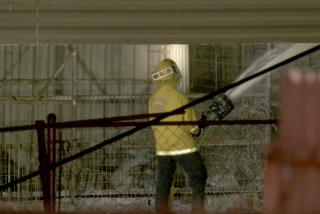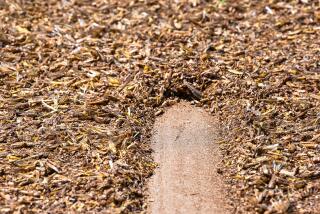Fear factor seems relevant in decomposing bug’s effect on soil
The next time you kill an insect, you might want to do it quickly — for the sake of the environment.
New research shows that whether an animal lives in safety or is terrorized by a predator can change the biochemical trajectory of the local ecosystem where it dies. The findings point to an expanded role for both predators and prey in their local environments, and may affect which species conservationists believe are most important to keep around.
The total mass of animals on the planet is puny compared with that of plants and bacteria. So researchers have long assumed that when a predator, like a spider, eats its prey, like a grasshopper, the main effect on the microbial environment is the obvious one: Fewer grasshoppers means more grass, changing the amount of plant matter available to the microscopic critters living below ground.
But a study published in Friday’s edition of the journal Science shows that when a grasshopper dies, the chemical composition of its decomposing body also has a large influence on the microscopic processes going on in the area’s soil. And the chemicals in the corpse are influenced by the dread of living near a killer spider.
To create a group of seriously stressed-out grasshoppers, researchers at a Yale University forest field site in Connecticut placed the bugs in an enclosure with spiders. (The spiders’ mouths were glued shut, but the grasshoppers didn’t know that.) This induced physiological changes in the scared grasshoppers that were not seen in a control group of grasshoppers that lived a predator-free existence, said study leader Dror Hawlena, an ecologist now at Hebrew University of Jerusalem.
“Their stress responses are very similar to humans’,” Hawlena said of the grasshoppers. “They increase their metabolic rate, use more energy for maintenance, and the proteins in their bodies begin to break down.”
The presence of spiders also changed the way the grasshoppers ate in a manner that mirrors the human response to stress, said Yale ecologist Oswald Schmitz, the study’s senior author.
“The grasshoppers stop eating grasses, which have lots of protein, and start eating goldenrods, which contain lots of carbohydrates,” Schmitz said. That’s similar to how stressed-out students reach for a bag of potato chips or a box of cookies the night before exams.
This switch from a protein-rich diet to a carbohydrate-heavy one turned out to be key. Protein contains enzymes and nitrogen that help microbes in the soil break down plant matter, and this process is a crucial part of normal ecosystem function.
The researchers ground up the grasshopper corpses and mixed them with soil. After six weeks, they added dead grass and watched to see how effectively the soil was able to break it down. They found that the dirt with the remains of calm grasshoppers was far more efficient in breaking down plant matter than the dirt containing the remains of stressed grasshoppers — between 60% and 200% better.
Joshua Schimel, an expert in soil ecology at UC Santa Barbara who was not involved in the study, said the size of the effect was “head-scratching.”
“The models we use to determine decomposition rates just assume that the bacteria do their job at a constant rate that isn’t dependent on these types of things,” Schimel said. “But our understanding is still very primitive — and the bacteria don’t read our textbooks.”
Steven Allison, an ecologist who studies the role of microbes in ecosystems at UC Irvine and who also wasn’t involved in the research, said the study was impressive because it included so many types of organisms. While people normally think of the food chain as involving large animals, he said, “below ground we also have a food chain. And it’s neat to see a study that shows interactions between multiple links in that food chain, both above ground and below ground.”
To Schmitz, the study reveals that the relationships between organisms — like predators and microbes — are both tenuous and complex, raising tough questions for conservationists.
“Every day we’re taking species we know basically nothing about and throwing them away without any possibility of bringing them back,” he said. “We need to think harder and more deeply about which species we need to keep around. And it may not be the cute and cuddly ones; it may be the scarier ones.”
For Hawlena, who once worked for Israel’s national parks, the results have changed the way he sees the natural world.
“If you look around you, in pretty much every spot something at some time has died — in one place a mouse, in another a grasshopper, in another a deer,” he said. “Each one of those places is going to behave totally differently from a microbial point of view. What you are seeing is the legacy of all that has died there.”
Think about that next time you step on a bug.






